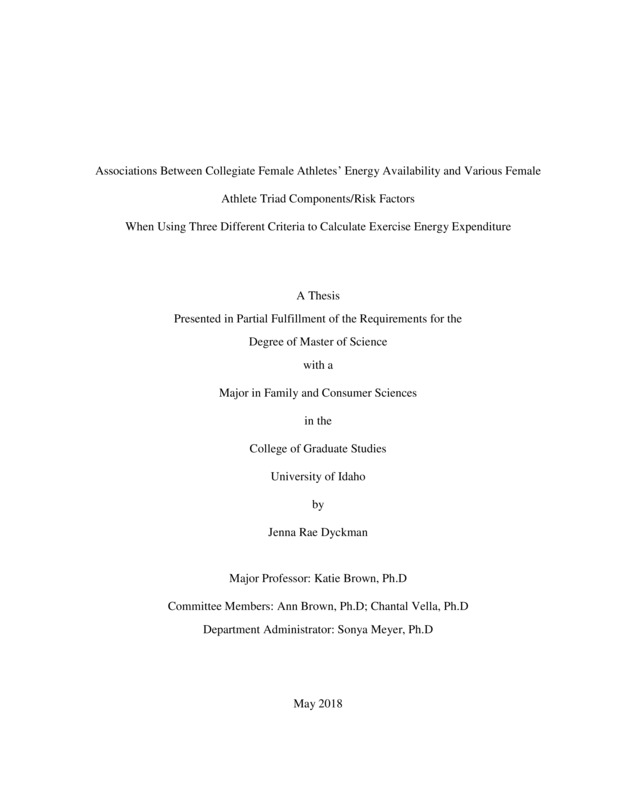Associations Between Collegiate Female Athletes' Energy Availability and Various Female Athlete Triad Components/Risk Factors When Using Three Different Criteria to Calculate Exercise Energy Expenditure
Dyckman, Jenna. (2018-05). Associations Between Collegiate Female Athletes' Energy Availability and Various Female Athlete Triad Components/Risk Factors When Using Three Different Criteria to Calculate Exercise Energy Expenditure. Theses and Dissertations Collection, University of Idaho Library Digital Collections. https://www.lib.uidaho.edu/digital/etd/items/dyckman_idaho_0089n_11385.html
- Title:
- Associations Between Collegiate Female Athletes' Energy Availability and Various Female Athlete Triad Components/Risk Factors When Using Three Different Criteria to Calculate Exercise Energy Expenditure
- Author:
- Dyckman, Jenna
- Date:
- 2018-05
- Program:
- Family and Consumer Sciences
- Subject Category:
- Nutrition
- Abstract:
-
The Female Athlete Triad is a disorder that includes energy availability, menstrual function, and bone mineral density (BMD). Energy availability (EA) has been designated as the root cause for female athletes for athletes developing MD and/or low BMD. Energy availability is defined as energy intake minus exercise energy expenditure (EEE) divided by lean body mass (LBM). In a study conducted in laboratory or controlled setting, indirect calorimetry is the standardized method for quantifying EEE. But for free-living studies, researchers have calculated EA using a variety of different criteria for quantifying EEE. In this study 19 participants wore triaxial accelerometers to collect EEE data, they kept exercise logs, and a record of food intake for four days (3 weekday days and 1 weekend day). To compare methods for quantifying EEE, three EEE criteria were used to calculate the participants’ EA. These three EEE criteria included total activity EEE, structured planned EEE, and METs ≥ 3 EEE. Participants also completed the Low Energy Availability in Female Questionnaire (LEAF-Q), a body composition assessment using the Bod-Pod, and a dual energy x-ray absorptiometry (DXA) scan. Using the three EEE criteria, low EA was the most prevalent Triad component among the participants (26-53%). Prevalence of MD was 26% (n=5) and low BMD prevalence was 15% (n=3). Prevalence for participants having at least one Triad component ranged from 53% to 68% and prevalence for participants with at least two Triad components ranged from 11-21%. No participants in this study qualified for all three components of the Triad. LEAF-Q results showed that this tool has the ability to predict if an athlete is at risk for at least one Triad component. However, the LEAF-Q is not able to identify which Triad component an athlete is at risk for. Overall, the three EEE criteria did not have perfect agreement. Results provide evidence that the total activity EEE criteria may best capture an athlete’s participation in not only their planned exercise but other physical activities that add to their daily energy expenditure.
- Description:
- masters, M.S., Family and Consumer Sciences -- University of Idaho - College of Graduate Studies, 2018-05
- Major Professor:
- Brown, Katie
- Committee:
- Brown, Ann; Vella, Chantal
- Defense Date:
- 2018-05
- Identifier:
- Dyckman_idaho_0089N_11385
- Type:
- Text
- Format Original:
- Format:
- application/pdf
- Rights:
- In Copyright - Educational Use Permitted. For more information, please contact University of Idaho Library Special Collections and Archives Department at libspec@uidaho.edu.
- Standardized Rights:
- http://rightsstatements.org/vocab/InC-EDU/1.0/

